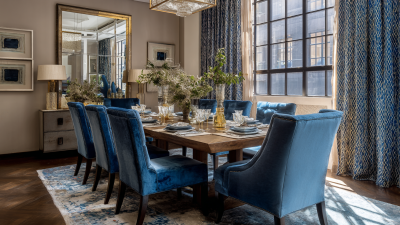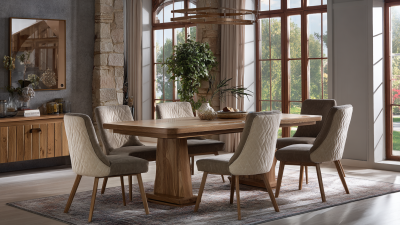10 Essential Tips for Choosing the Perfect Dining Table Set for Your Home
When it comes to creating a welcoming and functional dining space in your home, selecting the right dining table set is crucial. A recent report by the National Kitchen and Bath Association indicates that over 70% of homeowners consider the dining area a central hub for family gatherings and entertaining guests. Thus, investing in a quality dining table set can enhance not just the aesthetic appeal of your home but also elevate your dining experience.
Choosing the perfect dining table set involves various factors, from size and shape to material and design. According to a study by Furniture Today, consumers are increasingly prioritizing durable materials that suit their lifestyle, with over 50% of buyers opting for pieces made from sustainable resources. In an era where personalization and functionality reign supreme, understanding these dynamics can help you make an informed decision, ensuring that your dining table set complements both your space and your personal style.

Consider Your Space: Measuring for the Right Dining Table Size
When selecting the perfect dining table set, one of the most critical steps is to measure your space accurately. It’s not just about finding a table that looks great; it’s about ensuring that it fits seamlessly into your dining area. Begin by measuring the dimensions of the space where you intend to place the table. Consider the length, width, and height of the area, as well as any furniture or architectural elements that could impact the available space. Don't forget to account for clearance around the table, allowing for easy movement and access to chairs.
Once you have the measurements, think about the number of people you want to accommodate regularly. A standard dining table typically measures 60-72 inches in length and can seat six to eight people, but your needs may vary. Additionally, consider the shape of the table; round tables can be more space-efficient, while rectangular ones allow for more guests. The goal is to find a balance between a visually appealing set and one that provides functionality and comfort in your dining experience.
Dining Table Sizes and Space Requirements
Choosing the right dining table size for your space is crucial. This chart illustrates the recommended table sizes in square feet based on how many people the table needs to accommodate.
Choose the Right Material: Wood, Metal, or Glass for Your Style
When selecting the perfect dining table set for your home, one of the key aspects to consider is the material used. Each material has its unique characteristics that can greatly influence the overall look and durability of your dining space. For instance, wooden table sets exude warmth and a classic appeal, making them ideal for traditional and rustic interiors. On the other hand, metal tables can lend an industrial or contemporary vibe to your dining area, while glass tables are perfect for creating an illusion of space and adding a modern touch.
Tips for choosing the right material for your dining table set include understanding your lifestyle needs. If you have a busy household with children or frequent gatherings, opt for durable materials like solid wood or metal that can withstand wear and tear. Additionally, consider the ease of maintenance; glass tables may require more frequent cleaning but can offer a sleek, sophisticated look. Finally, think about the overall aesthetic of your home—select a material that complements your existing furnishings to create a cohesive design.
Think About Seating: Balancing Chair Styles and Comfort
When selecting the perfect dining table set, paying attention to seating is crucial. The comfort and style of chairs can significantly impact the dining experience. Aim for a balance between aesthetics and ergonomics. Consider the height and dimensions of the chairs in relation to the table, ensuring they're proportionate and comfortable for lengthy meals and gatherings.
One tip is to mix and match chair styles for a more personalized look while maintaining a cohesive theme. For instance, combining upholstered dining chairs with wooden ones can create an inviting and eclectic atmosphere. Additionally, always keep in mind the upholstery material; fabrics that are easy to clean will retain their appeal over time, especially in homes with children or pets.
Another important aspect is to test the comfort of your chosen chairs. Spend time sitting in different styles to gauge support and comfort. Don’t shy away from making adjustments, such as adding cushions or selecting chairs with adjustable height features. Comfort is paramount, as it invites family and friends to linger around the table, enhancing your dining experience.
Style It Up: Matching the Dining Table Set to Your Home Decor
When selecting a dining table set, it's crucial to ensure that it complements your home decor and reflects your personal style. Start by considering the overall theme of your home—whether it's modern, rustic, or eclectic—as this will guide your choice. For instance, a sleek glass table paired with metal chairs can enhance a contemporary space, while a sturdy wooden table with upholstered seating fits beautifully in a farmhouse setting. Color coordination is also key; aim for shades that blend harmoniously with your existing palette, using contrasting colors to create focal points.
Textures play a significant role in achieving a cohesive look. If your home features soft textiles and warm hues, opt for a dining set with plush seats and rounded edges to maintain a welcoming vibe. Alternatively, if your decor leans towards minimalism, choose angular lines and materials like metal or reclaimed wood for a chic, streamlined appearance. Finally, don’t forget about the accessories; the right centerpiece, table linens, and dinnerware can tie together your dining experience, ensuring that your dining table set not only serves a functional purpose but also enhances the aesthetic appeal of your dining area.
10 Essential Tips for Choosing the Perfect Dining Table Set for Your Home
| Tip Number | Tip | Description |
|---|---|---|
| 1 | Measure Your Space | Ensure you have enough room for the table and chairs, allowing for movement. |
| 2 | Consider the Shape | Choose a shape that fits your dining area—round, square, or rectangular. |
| 3 | Material Matters | Select materials that complement your style; wood for warmth, glass for elegance. |
| 4 | Think About Seating Capacity | Choose a set that can comfortably accommodate your family and guests. |
| 5 | Style Consistency | Ensure the dining set matches your home decor style, whether modern or traditional. |
| 6 | Check Durability | Invest in a durable dining set that withstands daily use. |
| 7 | Color Coordination | Select colors that coordinate with your existing decor for a cohesive look. |
| 8 | Functionality | Consider a multifunctional table, such as extending tables for extra space. |
| 9 | Research Brands | Look for reputable brands with good reviews to ensure quality. |
| 10 | Get Personal | Choose a dining set that reflects your personal taste and lifestyle. |
Budget Wisely: Finding Quality Dining Sets Within Your Price Range
When it comes to selecting the ideal dining table set, budgeting is crucial. A recent report from the American Home Furnishings Alliance indicates that approximately 34% of consumers consider price the most important factor when purchasing furniture. This statistic underscores the necessity of establishing a clear budget before you start shopping. By doing so, you not only narrow down your options but also ensure you invest in a set that balances both quality and aesthetic appeal without breaking the bank.
Consider allocating your budget based on the materials and craftsmanship, as these factors significantly influence durability and overall value. For instance, a study by Furniture Today reveals that solid wood dining sets last longer and maintain their appeal better than cheaper alternatives, making them a wise long-term investment. It's often advisable to spend a bit more on quality pieces that will withstand the test of time rather than opting for cheaper sets that may need to be replaced after a few years. By focusing on quality within your price range, you can create a dining space that combines functionality with a touch of elegance, ensuring satisfaction with your purchase for years to come.
Related Posts
-

Exploring the Future of Dining Room Tables in 2025 The Ultimate Guide to Innovative Trends
-

Creative Ways to Enhance Your Home with the Best Dining Room Table
-

7 Reasons Why the Best Dining Room Table Set Transforms Your Home Dining Experience
-

5 Essential Tips for Choosing the Best Dining Table Set for Your Home
-

How to Choose the Perfect Living Room Couch for Your Space and Style
-

Top Strategies for Choosing the Perfect Bedroom Table
